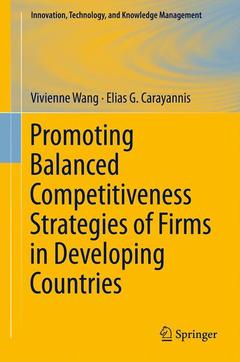Description
Promoting Balanced Competitiveness Strategies of Firms in Developing Countries, 2012
Innovation, Technology, and Knowledge Management Series, Vol. 12
Language: English
Subjects for Promoting Balanced Competitiveness Strategies of Firms...:
Keywords
Adaptive innovation; Competitive Position Model; Competitiveness; Developing countries; Incremental innovation; Innovation; Intellectual property rights; Knowedge management; Manufacturing industries; Research and Development (R&D); Technology Policy; Technology transfer; radical innovation
Publication date: 01-2014
128 p. · 15.5x23.5 cm · Paperback
128 p. · 15.5x23.5 cm · Hardback
Description
/li>Comment
/li>
Since the pioneering work of Joseph Schumpeter (1942), it has been assumed that innovations typically play a key role in firms? competitiveness. This assumption has been applied to firms in both developed and developing countries. However, the innovative capacities and business environments of firms in developing countries are fundamentally different from those in developed countries. It stands to reason that innovation and competitiveness models based on developed countries may not apply to developing countries.
In this volume, Vivienne Wang and Elias G. Carayannis apply both theoretical approaches and empirical analysis to explore the dynamics of innovation in developing countries, with a particular emphasis on R&D in manufacturing firms. In so doing, they present an alternative to Michael Porter?s Competitive Advantage Model?a Competitive Position Model that focuses on incremental and adaptive innovations that are more appropriate than radical innovations for developing countries. Their research addresses such questions as:
- Do innovations advance the competitive positions of manufacturing firms in developing countries?
- Does the pace of innovation matter, in particular, in socio-economic and socio-political contexts?
- To what degree can national innovation systems and policies influence development?
- To what extent do a firm?s innovation commitments correlate with the protection of intellectual property rights?
- What roles do foreign direct investment and relationships with clusters and networks play?
The resulting analysisnot only challenges traditional theoretical approaches to innovation, but provides suggestions for improving business practice and policymaking.




